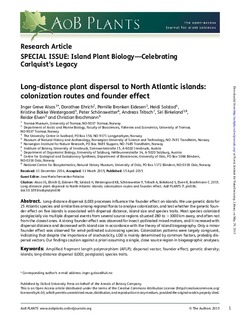| dc.contributor.author | Alsos, Inger Greve | |
| dc.contributor.author | Ehrich, Dorothee | |
| dc.contributor.author | Eidesen, Pernille Bronken | |
| dc.contributor.author | Solstad, Heidi Merethe | |
| dc.contributor.author | Westergaard, Kristine Bakke | |
| dc.contributor.author | Schonswetter, Peter | |
| dc.contributor.author | Tribsch, Andreas | |
| dc.contributor.author | Birkeland, Siri | |
| dc.contributor.author | Elven, Reidar | |
| dc.contributor.author | Brochmann, Christian | |
| dc.date.accessioned | 2017-10-04T07:32:42Z | |
| dc.date.available | 2017-10-04T07:32:42Z | |
| dc.date.created | 2015-05-29T10:33:50Z | |
| dc.date.issued | 2015 | |
| dc.identifier.citation | AoB Plants. 2015, 7 (1), 1-19. | nb_NO |
| dc.identifier.issn | 2041-2851 | |
| dc.identifier.uri | http://hdl.handle.net/11250/2458215 | |
| dc.description.abstract | Long-distance dispersal (LDD) processes influence the founder effect on islands.We use genetic data for 25 Atlantic species and similarities among regional floras to analyse colonization, and test whether the genetic founder effect on five islands is associated with dispersal distance, island size and species traits. Most species colonized postglacially via multiple dispersal events from several source regions situated 280 to .3000 km away, and often not from the closest ones. A strong founder effect was observed for insect-pollinated mixed maters, and it increased with dispersal distance and decreased with island size in accordance with the theory of island biogeography. Only a minor founder effect was observed for wind-pollinated outcrossing species. Colonization patterns were largely congruent, indicating that despite the importance of stochasticity, LDD is mainly determined by common factors, probably dispersal vectors. Our findings caution against a priori assuming a single, close source region in biogeographic analyses. Amplified fragment length polymorphism (AFLP); dispersal vector; founder effect; genetic diversity; islands; long-distance dispersal (LDD); postglacial; species traits. | nb_NO |
| dc.language.iso | eng | nb_NO |
| dc.publisher | Oxford University Press | nb_NO |
| dc.rights | Navngivelse 4.0 Internasjonal | * |
| dc.rights.uri | http://creativecommons.org/licenses/by/4.0/deed.no | * |
| dc.title | Long-distance plant dispersal to North Atlantic islands: colonization routes and founder effect | nb_NO |
| dc.type | Journal article | nb_NO |
| dc.type | Peer reviewed | nb_NO |
| dc.description.version | publishedVersion | nb_NO |
| dc.source.pagenumber | 1-19 | nb_NO |
| dc.source.volume | 7 | nb_NO |
| dc.source.journal | AoB Plants | nb_NO |
| dc.source.issue | 1 | nb_NO |
| dc.identifier.doi | 10.1093/aobpla/plv036 | |
| dc.identifier.cristin | 1245070 | |
| dc.relation.project | Norges forskningsråd: 454736 | nb_NO |
| dc.relation.project | Norges forskningsråd: 213692 | nb_NO |
| dc.relation.project | Norges forskningsråd: 150322 | nb_NO |
| dc.relation.project | Norges forskningsråd: 170952 | nb_NO |
| dc.relation.project | Norges forskningsråd: 230617 | nb_NO |
| dc.relation.project | Norges forskningsråd: 179569 | nb_NO |
| dc.description.localcode | &The Authors 2015. Published by Oxford University Press on behalf of the Annals of Botany Company.This is an Open Access article distributed under the terms of the Creative Commons Attribution License (http://creativecommons.org/licenses/by/4.0/), which permits unrestricted reuse, distribution, and reproduction in any medium, provided the original work is properly cited | nb_NO |
| cristin.unitcode | 194,31,10,0 | |
| cristin.unitname | Institutt for naturhistorie | |
| cristin.ispublished | true | |
| cristin.fulltext | original | |
| cristin.qualitycode | 1 | |

